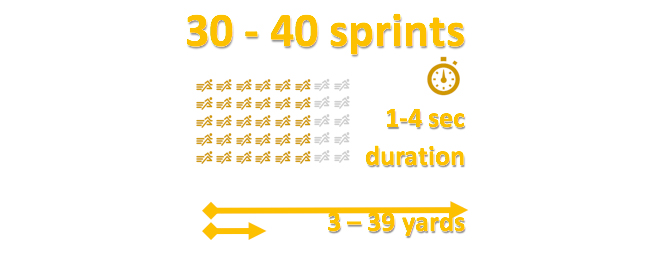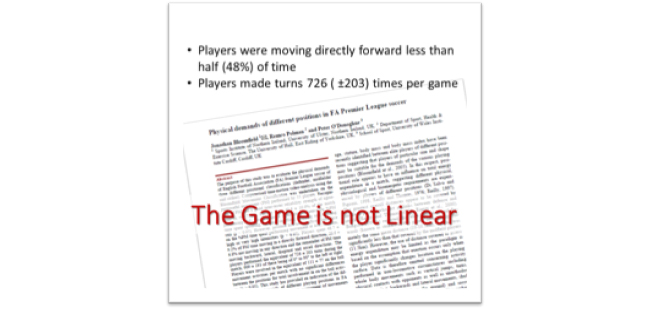What Is Fast in Soccer?
Everyone knows sprinting is an important part of soccer, but it doesn’t take an English Premier League coach to see that quickness, agility and change of direction are equally important aspects of game speed.
Today, with combinations of GPS and video tracking, we have more information than ever on the movement demands of soccer players around the world in different leagues and levels of competition. We now have data on everything from how many runs they make at different speeds, to how often they change direction.
What does it tell us? The game keeps getting faster each decade, and as you move up each level, if you want to compete you’d better be fast.
RELATED: Increase Your Soccer Speed With 4 Sprint Drills
Sprinting
During a match, a professional player may make between 30 to 40 sprints. They aren’t 100-Meter Dashes, but they do range from 1 to 4 seconds over distances of 3 to 39 yards.
Sprinting has two main components: acceleration and max velocity. Acceleration is speeding up rapidly, and maximum velocity is sprinting over 75 percent of full speed. Since the sprints range from 3 to 39 yards, we know soccer players need both. Performance coaches can tell you the biomechanics and technique for each are distinctly different.
Two differences you can clearly see between acceleration sprint mechanics and max velocity sprint mechanics are body angle and leg action.
Agility
Although sprinting speed is very important, soccer isn’t a track meet. It’s not a linear game, and elite players have great agility as well as blazing straight-ahead speed. Agility can be looked at in two key components, quickness and change of direction.
Sprinting speed is great, but if you cannot change direction, you’re going to get burned.
Quickness
Lightning-fast movements in one or two steps can make all the difference in reacting to an opponent or leaving one on the ground.
Change of Direction
The game isn’t linear. Players constantly change direction. As a player, the ability to do this faster and in fewer steps than your opponent gives you an edge.
Soccer-Specific Speed
To play your best game, you need several kinds of speed. Players are usually better at one kind or another, but you can’t afford any glaring holes. As an elite player you need:
- Acceleration
- Maximum Velocity
- Quickness
- Change of Direction
The good news is you don’t have to leave this to chance. Although you need the right genetics to be the fastest in the world at anything, you can get faster at every kind of speed with the proper training. Improve both your physical attributes and your motor control, and you’ll be faster. Speed is a skill, and like any skill, it can be taught.
RELATED: 3 Biggest Myths About Soccer Speed
RECOMMENDED FOR YOU
MOST POPULAR
What Is Fast in Soccer?
Everyone knows sprinting is an important part of soccer, but it doesn’t take an English Premier League coach to see that quickness, agility and change of direction are equally important aspects of game speed.
Today, with combinations of GPS and video tracking, we have more information than ever on the movement demands of soccer players around the world in different leagues and levels of competition. We now have data on everything from how many runs they make at different speeds, to how often they change direction.
What does it tell us? The game keeps getting faster each decade, and as you move up each level, if you want to compete you’d better be fast.
RELATED: Increase Your Soccer Speed With 4 Sprint Drills
Sprinting
During a match, a professional player may make between 30 to 40 sprints. They aren’t 100-Meter Dashes, but they do range from 1 to 4 seconds over distances of 3 to 39 yards.
Sprinting has two main components: acceleration and max velocity. Acceleration is speeding up rapidly, and maximum velocity is sprinting over 75 percent of full speed. Since the sprints range from 3 to 39 yards, we know soccer players need both. Performance coaches can tell you the biomechanics and technique for each are distinctly different.
Two differences you can clearly see between acceleration sprint mechanics and max velocity sprint mechanics are body angle and leg action.
Agility
Although sprinting speed is very important, soccer isn’t a track meet. It’s not a linear game, and elite players have great agility as well as blazing straight-ahead speed. Agility can be looked at in two key components, quickness and change of direction.
Sprinting speed is great, but if you cannot change direction, you’re going to get burned.
Quickness
Lightning-fast movements in one or two steps can make all the difference in reacting to an opponent or leaving one on the ground.
Change of Direction
The game isn’t linear. Players constantly change direction. As a player, the ability to do this faster and in fewer steps than your opponent gives you an edge.
Soccer-Specific Speed
To play your best game, you need several kinds of speed. Players are usually better at one kind or another, but you can’t afford any glaring holes. As an elite player you need:
- Acceleration
- Maximum Velocity
- Quickness
- Change of Direction
The good news is you don’t have to leave this to chance. Although you need the right genetics to be the fastest in the world at anything, you can get faster at every kind of speed with the proper training. Improve both your physical attributes and your motor control, and you’ll be faster. Speed is a skill, and like any skill, it can be taught.
RELATED: 3 Biggest Myths About Soccer Speed













